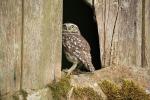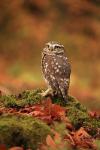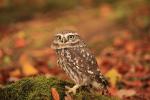Little Owl
The Little Owl (Anthene noctua) is not a native species to the uk, having been introduced to Britain in the 1870s. Today the little owl can be found in England and Wales, with a few in southern Scotland. It likes lowland farmland with hedges and copses, parkland, and orchards. They are most common in central, southern and south-eastern England and the Welsh borders.
The bird lives up to its name, standing at only 20cm in height, it has a short tail and is the smallest owl in the UK. It has piercing yellow eyes and mottled brown and cream colouring across its head and body. The wings are rounded and move with rapid wingbeats.
The little owl was introduced to the UK in the 19th century. It can be seen during the day usually perching on a tree branch, telegraph pole or rock. It will bob its head up and down when alarmed. In flight it has long, rounded wings, rapid wingbeats, and flies with a slight undulation. There are currently around 6,000 pairs of Little Owls in Britain.
Their diet consists of mostly small mammals and birds but will also feed on large invertebrates, such as beetles, crickets and worms. It hunts at dawn and dusk, scanning the ground from its perch for movement. Once the little owl spots its prey, it swoops, grabbing its meal in its claws or beak.
Little Owls are a cavity-nesting species, with nests recorded in rock crags, rabbit holes and haystacks as well as in buildings and tree holes. In the UK tree holes are by far the commonest natural site type. They will also readily take to man-made nest boxes. Little Owls are faithful to their nest sites and will return year after year, provided both of the pair survive. Between 3 and 5 eggs are normally laid towards the end of April, with incubation lasting about a month. The young chicks fledge at 5-6 weeks of age but are dependent on the adults for a further 2-4 weeks thereafter.
Unfortunately, the UK's little-owl population is in decline, having fallen by 18% since 1995. While it is unclear why the species is declining, some suggest it may be due to more intensive farming methods, with decreases in the availability of favoured hunting habitat and shrinking populations of certain prey. There is also some concern over environmental contaminants as well as climate change.
|






























